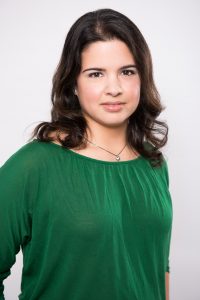Women in Power: Davianne Duarte
 Energy Solution Architect, Intel Corporation
Energy Solution Architect, Intel Corporation
Unlike some of my peers, I have taken a longer path to find my way to a career in Energy. As a kid my interests were between playing with My Little Pony and building Lego structures with my 2 brothers and sister. Luckily we have supportive parents who let us dream and support activities which we thought were fun. This included my pursuit of playing the Oboe from grade school through high school, tolerating the sounds of my poor skills (according to my siblings it sounded like a dying duck). While pursuing my musical interests I also grew to love science, math and always enjoyed a good challenge. If there was a hard teacher, I wanted to be in his or her class. This meant that sometimes I didn’t get the best grades but I was able to learn a lot of cool things that were outside of my expertise. In the end, all the hard work led me to obtaining a B.S. in Chemical Engineering and an M.S./ PhD in Electrical Engineering and eventually moving into my current position as an Energy Solution Architect at Intel Corporation.
When one is so young and figuring out what field to pursue for your undergraduate degree, it can be a bit limiting. Most of the time you go in thinking your decision is final, but the reality is a person changes as they mature. I went to the University of California at Irvine thinking I would do Aerospace Engineering, but during the welcome day for incoming students I decided it wasn’t for me and I wanted to do Chemical Engineering. This stemmed from having an awesome advanced chemistry teacher who show us young students the power of chemistry. So that day I made the change and worked my tail off for the next 5 years while taking intermittent breaks for internships at Lawrence Livermore National Laboratory and Intel. These internships opened my mind to a wider range of possibilities and the realization that I was much better at understanding electronics then chemistry.
After graduation I took a year off for some reflection- worked at Intel for an eight month period, and traveled to New Zealand and Australia for a few months using some of the money I saved up. During that time I aslo took the GRE and applied to a few masters degree programs in Electrical Engineering, eventually choosing California Polytechnic San Luis Obispo. I worked at Intel intermittently while going to school and started to learn more about organic electronics, using conductive polymers for electric circuits. I decided that was a great use of both chemical and electrical and engineering and moved on to study organic electronics for my PhD at The University of Texas (UT) at Austin. I received a fellowship from Intel to support my work along with a fellowship from UT Austin.
After conducting a postdoc I eventually came to Intel to work on their chip development initiatives to keep Moore’s Law alive. I gained some new data science skills and learned the complex processes it takes to produce the microchips that go in to so many pieces of technology we use today. I found the work interesting work but not fulfilling for me. As I took some time for reflection I did some reading in the area of energy/smart grid technology and realized how much we take our electrical grid for granted. I specifically remember a reading a Mckinsey article on how developing nations will have a hard time increasing their GDP without a better electrical infrastructure. I decided it was time for a career change and energy was where I wanted to apply my skills. This led me to taking the Smart Grid Technology class at Portland State University from Jeff Hammarlund. The class was an awesome experience and it allowed me to connect with other energy professionals in the Pacific Northwest. I participated in a group project conduction a technology assessment for the Northwest Power and Conservation Council’s Seventh Power
Plan. I also gained some great mentors including Peter Lee (Bonneville Power Administration business analyst), Mark Osborne (former Portland General Electric engineer), and Dan Bihn (engineer storyteller). Eventually with their help I was able to move into my current role as an Energy Solution Architect at Intel. I have the privilege of working with utilities and various business groups within Intel to provide solutions which will help enable a smarter grid.
Outside of work I enjoy participating in many STEAM outreach programs for girls and under-represented minorities. Teaching young students the possibilities through coding and hardware is very fulfilling. I am a IEEE Women in Engineering and Women in Power member and I am looking forward to engaging in more outreach activities under those umbrellas.
Save
